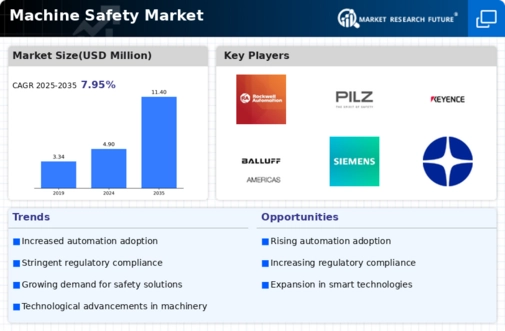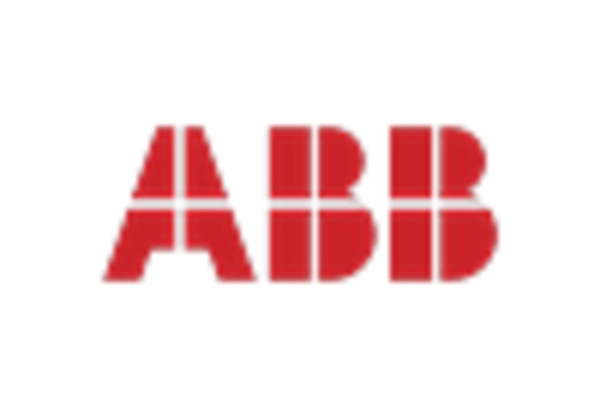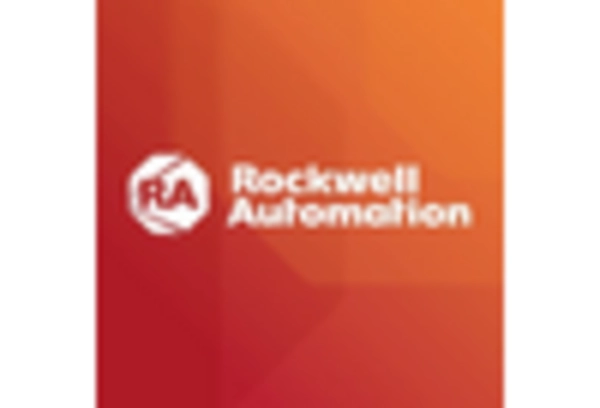-
EXECUTIVE SUMMARY 17
-
MARKET ATTRACTIVENESS
-
ANALYSIS 18
-
MARKET INTRODUCTION 19
-
DEFINITION 19
-
SCOPE
-
OF THE STUDY 19
-
RESEARCH OBJECTIVE 19
-
MARKET STRUCTURE 20
-
RESEARCH METHODOLOGY 21
-
MARKET DYNAMICS 28
-
INTRODUCTION 28
- STRICT MACHINE SAFETY MANDATES 29
- HIGH REQUIREMENTS
- DRIVERS IMPACT ANALYSIS
-
DRIVERS 29
-
FOR RELIABLE SAFETY SYSTEMS TO ASSET PROTECTION 29
-
RESTRAINTS 31
- REQUIREMENTS FOR HUGE CAPITAL TO INSTALL AND
-
AUTOMATE MACHINE SAFETY SYSTEMS 31
-
OPPORTUNITIES 31
- INCREASING
-
USE OF IOT TO ENSURE BETTER MANAGEMENT AND IMPROVED PERFORMANCE OF MACHINE ASSETS
-
IMPACT ANALYSIS OF COVID-19 32
- IMPACT ON DEMAND AND SUBSEQUENT
- IMPACT ON SEMICONDUCTOR MANUFACTURERS
- IMPACT ON COMPONENT MANUFACTURERS 32
- COVID-19 IMPACT ON
-
DECLINE IN MACHINE SAFETY MARKET 32
-
SUPPLY CHAIN DELAY 33
-
MARKET FACTOR ANALYSIS 34
-
SUPPLY CHAIN 34
- COMPANIES/DISTRIBUTORS 34
- END USERS 35
-
PORTER''S FIVE
- THREAT OF NEW ENTRANTS 36
- BARGAINING POWER
- BARGAINING POWER OF BUYERS 36
- THREAT OF SUBSTITUTES
- INTENSITY OF RIVALRY 36
-
FORCES MODEL 35
-
OF SUPPLIERS 36
-
GLOBAL MACHINE SAFETY MARKET, BY COMPONENT
-
OVERVIEW 37
- GLOBAL MACHINE SAFETY MARKET, BY COMPONENT, 2024
-
-2032(USD MILLION) 38
-
PRESENCE-SENSING SAFETY SENSORS 38
-
EMERGENCY
-
STOP DEVICES 38
-
PROGRAMMABLE SAFETY SYSTEMS 38
-
SAFETY CONTROLLER/MODULES/RELAYS
-
SAFETY INTERLOCK SWITCHES 39
-
TWO-HAND SAFETY CONTROLS 39
-
OTHERS 39
-
GLOBAL MACHINE SAFETY MARKET, BY IMPLEMENTATION 40
-
OVERVIEW 40
-
(USD MILLION) 41
-
GLOBAL MACHINE SAFETY MARKET, BY IMPLEMENTATION, 2024 -2032
-
INDIVIDUAL COMPONENTS 41
-
EMBEDDED COMPONENTS
-
GLOBAL MACHINE SAFETY MARKET, BY APPLICATION 42
-
OVERVIEW 42
- GLOBAL MACHINE SAFETY MARKET, BY APPLICATION, 2024 -2032(USD MILLION) 43
-
ASSEMBLY 43
-
MATERIAL HANDLING 43
-
METAL WORKING 43
-
PACKAGING 43
-
ROBOTICS 43
-
OTHERS 43
-
GLOBAL MACHINE SAFETY
-
MARKET, BY INDUSTRY 44
-
OVERVIEW 44
- GLOBAL MACHINE SAFETY MARKET,
-
BY INDUSTRY, 2024 -2032(USD MILLION) 45
-
OIL & GAS 45
-
CHEMICALS
-
AEROSPACE 45
-
SEMICONDUCTOR & ELECTRONICS 45
-
FOOD
-
& BEVERAGES 46
-
AUTOMOTIVE 46
-
HEALTHCARE 46
-
OTHERS
-
GLOBAL MACHINE SAFETY MARKET, BY REGION 47
-
OVERVIEW 47
- GLOBAL MACHINE SAFETY MARKET, BY REGION, 2022 VS 2032(USD MILLION) 47
- GLOBAL MACHINE SAFETY MARKET, BY REGION, 2024 -2032(USD MILLION) 48
-
NORTH AMERICA 49
- NORTH AMERICA: MACHINE SAFETY MARKET, BY COUNTRY,
- NORTH AMERICA MACHINE SAFETY MARKET, BY COMPONENT,
- NORTH AMERICA MACHINE SAFETY MARKET, BY IMPLEMENTATION,
- NORTH AMERICA MACHINE SAFETY MARKET, BY APPLICATION,
- NORTH AMERICA MACHINE SAFETY MARKET, BY INDUSTRY,
- US 53
- US MACHINE SAFETY MARKET,
- US MACHINE SAFETY MARKET, BY
- US MACHINE SAFETY MARKET,
- US MACHINE SAFETY MARKET,
- CANADA 55
- CANADA
-
BY COMPONENT, 2024 -2032(USD MILLION) 53
-
IMPLEMENTATION, 2024 -2032(USD MILLION) 54
-
BY APPLICATION, 2024 -2032(USD MILLION) 54
-
BY INDUSTRY, 2024 -2032(USD MILLION) 54
-
MACHINE SAFETY MARKET, BY COMPONENT, 2024 -2032(USD MILLION) 55
-
CANADA
-
MACHINE SAFETY MARKET, BY IMPLEMENTATION, 2024 -2032(USD MILLION) 55
-
CANADA MACHINE SAFETY MARKET, BY APPLICATION, 2024 -2032(USD MILLION) 55
-
CANADA MACHINE SAFETY MARKET, BY INDUSTRY, 2024 -2032(USD MILLION) 56
-
MEXICO 56
-
MILLION) 56
-
MILLION) 57
-
MILLION) 57
-
MILLION) 57
-
BY COMPONENT, 2024 -2032(USD MILLION) 62
-
IMPLEMENTATION, 2024 -2032(USD MILLION) 63
-
BY APPLICATION, 2024 -2032(USD MILLION) 63
-
BY INDUSTRY, 2024 -2032(USD MILLION) 63
-
MEXICO MACHINE SAFETY MARKET, BY COMPONENT, 2024 -2032(USD
-
MEXICO MACHINE SAFETY MARKET, BY IMPLEMENTATION, 2024 -2032(USD
-
MEXICO MACHINE SAFETY MARKET, BY APPLICATION, 2024 -2032(USD
-
MEXICO MACHINE SAFETY MARKET, BY INDUSTRY, 2024 -2032(USD
-
EUROPE 58
- EUROPE: MACHINE SAFETY MARKET, BY COUNTRY,
- EUROPE MACHINE SAFETY MARKET, BY COMPONENT,
- EUROPE MACHINE SAFETY MARKET, BY IMPLEMENTATION,
- EUROPE MACHINE SAFETY MARKET, BY APPLICATION,
- EUROPE MACHINE SAFETY MARKET, BY INDUSTRY,
- UK 62
- UK MACHINE SAFETY MARKET,
- UK MACHINE SAFETY MARKET, BY
- UK MACHINE SAFETY MARKET,
- UK MACHINE SAFETY MARKET,
- GERMANY 64
- GERMANY
-
MACHINE SAFETY MARKET, BY COMPONENT, 2024 -2032(USD MILLION) 64
-
GERMANY
-
MACHINE SAFETY MARKET, BY IMPLEMENTATION, 2024 -2032(USD MILLION) 64
-
GERMANY MACHINE SAFETY MARKET, BY APPLICATION, 2024 -2032(USD MILLION) 64
-
GERMANY MACHINE SAFETY MARKET, BY INDUSTRY, 2024 -2032(USD MILLION) 65
-
FRANCE 65
-
MILLION) 65
-
MILLION) 66
-
MILLION) 66
-
MILLION) 66
-
FRANCE MACHINE SAFETY MARKET, BY COMPONENT, 2024 -2032(USD
-
FRANCE MACHINE SAFETY MARKET, BY IMPLEMENTATION, 2024 -2032(USD
-
FRANCE MACHINE SAFETY MARKET, BY APPLICATION, 2024 -2032(USD
-
FRANCE MACHINE SAFETY MARKET, BY INDUSTRY, 2024 -2032(USD
-
SPAIN 67
-
SPAIN MACHINE SAFETY MARKET, BY COMPONENT,
-
SPAIN MACHINE SAFETY MARKET, BY IMPLEMENTATION,
-
SPAIN MACHINE SAFETY MARKET, BY APPLICATION,
-
SPAIN MACHINE SAFETY MARKET, BY INDUSTRY,
-
ITALY 68
-
ITALY MACHINE SAFETY
-
MARKET, BY COMPONENT, 2024 -2032(USD MILLION) 68
-
ITALY MACHINE SAFETY
-
MARKET, BY IMPLEMENTATION, 2024 -2032(USD MILLION) 69
-
ITALY MACHINE
-
SAFETY MARKET, BY APPLICATION, 2024 -2032(USD MILLION) 69
-
ITALY MACHINE
-
SAFETY MARKET, BY INDUSTRY, 2024 -2032(USD MILLION) 69
-
MILLION) 70
-
APPLICATION, 2024 -2032(USD MILLION) 71
-
REST OF EUROPE
-
REST OF EUROPE MACHINE SAFETY MARKET, BY COMPONENT, 2024 -2032(USD
-
REST OF EUROPE MACHINE SAFETY MARKET, BY IMPLEMENTATION,
-
REST OF EUROPE MACHINE SAFETY MARKET, BY
-
REST OF EUROPE MACHINE SAFETY
-
MARKET, BY INDUSTRY, 2024 -2032(USD MILLION) 71
-
ASIA-PACIFIC 72
-
ASIA-PACIFIC: MACHINE SAFETY MARKET, BY COUNTRY, 2024 -2032(USD MILLION) 73
-
ASIA-PACIFIC MACHINE SAFETY MARKET, BY COMPONENT, 2024 -2032(USD MILLION) 73
-
MILLION) 75
-
MILLION) 76
-
ASIA-PACIFIC MACHINE SAFETY MARKET, BY IMPLEMENTATION, 2024 -2032(USD MILLION)
-
ASIA-PACIFIC MACHINE SAFETY MARKET, BY APPLICATION, 2024 -2032(USD
-
ASIA-PACIFIC MACHINE SAFETY MARKET, BY INDUSTRY, 2024 -2032(USD
-
CHINA 76
-
CHINA MACHINE SAFETY MARKET, BY COMPONENT,
-
CHINA MACHINE SAFETY MARKET, BY IMPLEMENTATION,
-
CHINA MACHINE SAFETY MARKET, BY APPLICATION,
-
CHINA MACHINE SAFETY MARKET, BY INDUSTRY,
-
JAPAN 78
-
JAPAN MACHINE SAFETY
-
MARKET, BY COMPONENT, 2024 -2032(USD MILLION) 78
-
JAPAN MACHINE SAFETY
-
MARKET, BY IMPLEMENTATION, 2024 -2032(USD MILLION) 78
-
JAPAN MACHINE
-
SAFETY MARKET, BY APPLICATION, 2024 -2032(USD MILLION) 78
-
JAPAN MACHINE
-
SAFETY MARKET, BY INDUSTRY, 2024 -2032(USD MILLION) 79
-
INDIA 79
-
INDIA MACHINE SAFETY MARKET, BY COMPONENT, 2024 -2032(USD MILLION) 79
-
INDIA MACHINE SAFETY MARKET, BY IMPLEMENTATION, 2024 -2032(USD MILLION)
-
INDIA MACHINE SAFETY MARKET, BY APPLICATION, 2024 -2032(USD MILLION)
-
INDIA MACHINE SAFETY MARKET, BY INDUSTRY, 2024 -2032(USD MILLION)
-
REST OF ASIA-PACIFIC 81
-
REST OF ASIA-PACIFIC MACHINE
-
SAFETY MARKET, BY COMPONENT, 2024 -2032(USD MILLION) 81
-
REST OF ASIA-PACIFIC
-
MACHINE SAFETY MARKET, BY IMPLEMENTATION, 2024 -2032(USD MILLION) 81
-
REST OF ASIA-PACIFIC MACHINE SAFETY MARKET, BY APPLICATION, 2024 -2032(USD MILLION)
-
MILLION) 82
-
REST OF ASIA-PACIFIC MACHINE SAFETY MARKET, BY INDUSTRY, 2024 -2032(USD
-
MIDDLE EAST & AFRICA 83
- MIDDLE EAST &
-
AFRICA MACHINE SAFETY MARKET, BY COMPONENT, 2024 -2032(USD MILLION) 83
-
MIDDLE EAST & AFRICA MACHINE SAFETY MARKET, BY IMPLEMENTATION, 2024 -2032(USD
-
MILLION) 84
-
BY INDUSTRY, 2024 -2032(USD MILLION) 86
-
MIDDLE EAST & AFRICA MACHINE SAFETY MARKET, BY APPLICATION,
-
MIDDLE EAST & AFRICA MACHINE SAFETY MARKET,
-
SOUTH AMERICA 87
- SOUTH
-
AMERICA MACHINE SAFETY MARKET, BY COMPONENT, 2024 -2032(USD MILLION) 87
-
SOUTH AMERICA MACHINE SAFETY MARKET, BY IMPLEMENTATION, 2024 -2032(USD MILLION)
-
MILLION) 89
-
MILLION) 90
-
SOUTH AMERICA MACHINE SAFETY MARKET, BY APPLICATION, 2024 -2032(USD
-
SOUTH AMERICA MACHINE SAFETY MARKET, BY INDUSTRY, 2024 -2032(USD
-
COMPETITVE LANDSCAPE 91
-
COMPETITIVE BENCHMARKING 92
-
VENDOR SHARE ANALYSIS 93
-
RECENT DEVELOPMENTS 93
- PRODUCT
- PARTNERSHIPS/AGREEMENTS/CONTRACTS/COLLABORATIONS 95
-
DEVELOPMENT 93
-
COMPANY PROFILES 96
-
ROCKWELL AUTOMATION, INC. 96
- COMPANY
- FINANCIAL OVERVIEW 97
- PRODUCTS/SOLUTIONS/SERVICES
- KEY DEVELOPMENTS 99
- SWOT ANALYSIS 99
-
OVERVIEW 96
-
OFFERED 98
-
KEY STRATEGIES 100
-
HONEYWELL INTERNATIONAL, INC. 101
- COMPANY
- FINANCIAL OVERVIEW 102
- PRODUCTS/SOLUTIONS/SERVICES
- KEY DEVELOPMENTS 104
- SWOT ANALYSIS 105
-
OVERVIEW 101
-
OFFERED 102
-
KEY STRATEGIES 105
-
SICK AG 106
- COMPANY OVERVIEW 106
- PRODUCTS/SOLUTIONS/SERVICES OFFERED 107
- SWOT ANALYSIS 109
- KEY STRATEGIES 109
-
FINANCIAL OVERVIEW 106
-
KEY DEVELOPMENTS 108
-
ABB GROUP 110
- COMPANY OVERVIEW 110
- FINANCIAL OVERVIEW
- PRODUCTS/SOLUTIONS/SERVICES OFFERED 111
- KEY DEVELOPMENTS
- SWOT ANALYSIS 113
- KEY STRATEGIES 113
-
SCHNEIDER
- COMPANY OVERVIEW 114
- FINANCIAL OVERVIEW
- PRODUCTS/SOLUTIONS/SERVICES OFFERED 115
- KEY DEVELOPMENTS
- SWOT ANALYSIS 117
- KEY STRATEGIES 117
-
ELECTRIC SE 114
-
MITSUBISHI
- COMPANY OVERVIEW 118
- FINANCIAL
- PRODUCTS/SOLUTIONS/SERVICES OFFERED 119
- KEY
- SWOT ANALYSIS 120
- KEY STRATEGIES 120
-
ELECTRIC CORPORATION 118
-
OVERVIEW 119
-
DEVELOPMENTS 120
-
PILZ GMBH & CO. KG 121
- COMPANY OVERVIEW 121
- FINANCIAL
- PRODUCTS/SOLUTIONS/SERVICES OFFERED 121
- KEY
-
OVERVIEW 121
-
DEVELOPMENTS 122
-
KEYENCE CORPORATION 123
- COMPANY OVERVIEW
- FINANCIAL OVERVIEW 124
- PRODUCTS/SOLUTIONS/SERVICES OFFERED
- KEY DEVELOPMENTS 125
- SWOT ANALYSIS 125
- KEY
-
STRATEGIES 125
-
BANNER ENGINEERING CORP 126
- COMPANY OVERVIEW
- FINANCIAL OVERVIEW 126
- PRODUCTS/SOLUTIONS/SERVICES OFFERED
- KEY DEVELOPMENTS 126
-
OMRON CORPORATION 127
- FINANCIAL OVERVIEW 128
- PRODUCTS/SOLUTIONS/SERVICES
- KEY DEVELOPMENTS 129
- SWOT ANALYSIS 130
- KEY STRATEGIES 130
-
COMPANY OVERVIEW 127
-
OFFERED 129
-
BALLUFF INC 131
- COMPANY OVERVIEW
- FINANCIAL OVERVIEW 131
- PRODUCTS/SOLUTIONS/SERVICES
- KEY DEVELOPMENTS 131
-
OFFERED 131
-
YOKOGAWA ELECTRIC CORPORATION
- COMPANY OVERVIEW 132
- FINANCIAL OVERVIEW 133
- KEY DEVELOPMENTS 134
- KEY STRATEGIES 135
-
PRODUCTS/SOLUTIONS/SERVICES OFFERED 134
-
SWOT ANALYSIS 135
-
SIEMENS 136
- FINANCIAL OVERVIEW 137
- PRODUCTS/SOLUTIONS/SERVICES
- KEY DEVELOPMENTS 138
- SWOT ANALYSIS 138
- KEY STRATEGIES 138
-
COMPANY OVERVIEW 136
-
OFFERED 137
-
DATALOGIC 139
- COMPANY OVERVIEW
- FINANCIAL OVERVIEW 140
- PRODUCTS/SOLUTIONS/SERVICES
- KEY DEVELOPMENTS 141
- SWOT ANALYSIS 141
- KEY STRATEGIES 141
-
OFFERED 140
-
PHOENIX CONTACT 142
- COMPANY
- FINANCIAL OVERVIEW 142
- PRODUCTS/SOLUTIONS/SERVICES
- KEY DEVELOPMENTS 142
-
OVERVIEW 142
-
OFFERED 142
-
-
LIST OF TABLES
-
MARKET SYNOPSIS 17
-
GLOBAL MACHINE SAFETY MARKET, BY COMPONENT,
-
GLOBAL MACHINE SAFETY MARKET, BY IMPLEMENTATION,
-
GLOBAL MACHINE SAFETY MARKET, BY APPLICATION,
-
GLOBAL MACHINE SAFETY MARKET, BY INDUSTRY,
-
GLOBAL MACHINE SAFETY MARKET, BY REGION,
-
NORTH AMERICA MACHINE SAFETY MARKET, BY
-
COUNTRY, 2024 -2032(USD MILLION) 50
-
NORTH AMERICA MACHINE SAFETY MARKET,
-
BY COMPONENT, 2024 -2032(USD MILLION) 50
-
NORTH AMERICA MACHINE SAFETY
-
MARKET, BY IMPLEMENTATION, 2024 -2032(USD MILLION) 51
-
NORTH AMERICA
-
MACHINE SAFETY MARKET, BY APPLICATION, 2024 -2032(USD MILLION) 52
-
TABLE 11
-
NORTH AMERICA MACHINE SAFETY MARKET, BY INDUSTRY, 2024 -2032(USD MILLION) 53
-
US MACHINE SAFETY MARKET, BY COMPONENT, 2024 -2032(USD MILLION) 53
-
US MACHINE SAFETY MARKET, BY IMPLEMENTATION, 2024 -2032(USD MILLION)
-
US MACHINE SAFETY MARKET, BY APPLICATION, 2024 -2032(USD MILLION)
-
US MACHINE SAFETY MARKET, BY INDUSTRY, 2024 -2032(USD MILLION)
-
CANADA MACHINE SAFETY MARKET, BY COMPONENT, 2024 -2032(USD MILLION)
-
CANADA MACHINE SAFETY MARKET, BY IMPLEMENTATION, 2024 -2032(USD
-
MILLION) 55
-
CANADA MACHINE SAFETY MARKET, BY APPLICATION, 2024 -2032(USD
-
MILLION) 55
-
CANADA MACHINE SAFETY MARKET, BY INDUSTRY, 2024 -2032(USD
-
MILLION) 56
-
MEXICO MACHINE SAFETY MARKET, BY COMPONENT, 2024 -2032(USD
-
MILLION) 56
-
MEXICO MACHINE SAFETY MARKET, BY IMPLEMENTATION, 2024
-
-2032(USD MILLION) 57
-
MEXICO MACHINE SAFETY MARKET, BY APPLICATION,
-
MEXICO MACHINE SAFETY MARKET, BY INDUSTRY,
-
EUROPE MACHINE SAFETY MARKET, BY COUNTRY,
-
EUROPE MACHINE SAFETY MARKET, BY COMPONENT,
-
EUROPE MACHINE SAFETY MARKET, BY IMPLEMENTATION,
-
EUROPE MACHINE SAFETY MARKET, BY APPLICATION,
-
EUROPE MACHINE SAFETY MARKET, BY INDUSTRY,
-
UK MACHINE SAFETY MARKET, BY COMPONENT,
-
UK MACHINE SAFETY MARKET, BY IMPLEMENTATION,
-
UK MACHINE SAFETY MARKET, BY APPLICATION,
-
UK MACHINE SAFETY MARKET, BY INDUSTRY,
-
GERMANY MACHINE SAFETY MARKET, BY COMPONENT,
-
GERMANY MACHINE SAFETY MARKET, BY IMPLEMENTATION,
-
GERMANY MACHINE SAFETY MARKET, BY APPLICATION,
-
GERMANY MACHINE SAFETY MARKET, BY INDUSTRY,
-
FRANCE MACHINE SAFETY MARKET, BY COMPONENT,
-
FRANCE MACHINE SAFETY MARKET, BY IMPLEMENTATION,
-
FRANCE MACHINE SAFETY MARKET, BY APPLICATION,
-
FRANCE MACHINE SAFETY MARKET, BY INDUSTRY,
-
SPAIN MACHINE SAFETY MARKET, BY COMPONENT,
-
SPAIN MACHINE SAFETY MARKET, BY IMPLEMENTATION,
-
SPAIN MACHINE SAFETY MARKET, BY APPLICATION,
-
SPAIN MACHINE SAFETY MARKET, BY INDUSTRY,
-
ITALY MACHINE SAFETY MARKET, BY COMPONENT,
-
ITALY MACHINE SAFETY MARKET, BY IMPLEMENTATION,
-
ITALY MACHINE SAFETY MARKET, BY APPLICATION,
-
ITALY MACHINE SAFETY MARKET, BY INDUSTRY,
-
REST OF EUROPE MACHINE SAFETY MARKET, BY
-
COMPONENT, 2024 -2032(USD MILLION) 70
-
REST OF EUROPE MACHINE SAFETY
-
MARKET, BY IMPLEMENTATION, 2024 -2032(USD MILLION) 70
-
REST OF EUROPE
-
MACHINE SAFETY MARKET, BY APPLICATION, 2024 -2032(USD MILLION) 71
-
TABLE 52
-
REST OF EUROPE MACHINE SAFETY MARKET, BY INDUSTRY, 2024 -2032(USD MILLION) 71
-
ASIA-PACIFIC MACHINE SAFETY MARKET, BY COUNTRY, 2024 -2032(USD MILLION)
-
ASIA-PACIFIC MACHINE SAFETY MARKET, BY COMPONENT, 2024 -2032(USD
-
MILLION) 73
-
ASIA-PACIFIC MACHINE SAFETY MARKET, BY IMPLEMENTATION,
-
ASIA-PACIFIC MACHINE SAFETY MARKET, BY
-
APPLICATION, 2024 -2032(USD MILLION) 75
-
ASIA-PACIFIC MACHINE SAFETY
-
MARKET, BY INDUSTRY, 2024 -2032(USD MILLION) 76
-
CHINA MACHINE SAFETY
-
MARKET, BY COMPONENT, 2024 -2032(USD MILLION) 76
-
CHINA MACHINE SAFETY
-
MARKET, BY IMPLEMENTATION, 2024 -2032(USD MILLION) 77
-
CHINA MACHINE
-
SAFETY MARKET, BY APPLICATION, 2024 -2032(USD MILLION) 77
-
CHINA MACHINE
-
SAFETY MARKET, BY INDUSTRY, 2024 -2032(USD MILLION) 77
-
JAPAN MACHINE
-
SAFETY MARKET, BY COMPONENT, 2024 -2032(USD MILLION) 78
-
JAPAN MACHINE
-
SAFETY MARKET, BY IMPLEMENTATION, 2024 -2032(USD MILLION) 78
-
JAPAN
-
MACHINE SAFETY MARKET, BY APPLICATION, 2024 -2032(USD MILLION) 78
-
TABLE 65
-
JAPAN MACHINE SAFETY MARKET, BY INDUSTRY, 2024 -2032(USD MILLION) 79
-
TABLE
-
INDIA MACHINE SAFETY MARKET, BY COMPONENT, 2024 -2032(USD MILLION) 79
-
TABLE
-
INDIA MACHINE SAFETY MARKET, BY IMPLEMENTATION, 2024 -2032(USD MILLION) 80
-
INDIA MACHINE SAFETY MARKET, BY APPLICATION, 2024 -2032(USD MILLION)
-
INDIA MACHINE SAFETY MARKET, BY INDUSTRY, 2024 -2032(USD MILLION)
-
REST OF ASIA-PACIFIC MACHINE SAFETY MARKET, BY COMPONENT, 2024
-
-2032(USD MILLION) 81
-
REST OF ASIA-PACIFIC MACHINE SAFETY MARKET,
-
BY IMPLEMENTATION, 2024 -2032(USD MILLION) 81
-
REST OF ASIA-PACIFIC
-
MACHINE SAFETY MARKET, BY APPLICATION, 2024 -2032(USD MILLION) 82
-
TABLE 73
-
REST OF ASIA-PACIFIC MACHINE SAFETY MARKET, BY INDUSTRY, 2024 -2032(USD MILLION)
-
MIDDLE EAST & AFRICA MACHINE SAFETY MARKET, BY COMPONENT, 2024
-
-2032(USD MILLION) 83
-
MIDDLE EAST & AFRICA MACHINE SAFETY MARKET,
-
BY IMPLEMENTATION, 2024 -2032(USD MILLION) 84
-
MIDDLE EAST & AFRICA
-
MACHINE SAFETY MARKET, BY APPLICATION, 2024 -2032(USD MILLION) 85
-
TABLE 77
-
MIDDLE EAST & AFRICA MACHINE SAFETY MARKET, BY INDUSTRY, 2024 -2032(USD MILLION)
-
SOUTH AMERICA MACHINE SAFETY MARKET, BY COMPONENT, 2024 -2032(USD
-
MILLION) 87
-
SOUTH AMERICA MACHINE SAFETY MARKET, BY IMPLEMENTATION,
-
SOUTH AMERICA MACHINE SAFETY MARKET, BY
-
APPLICATION, 2024 -2032(USD MILLION) 89
-
SOUTH AMERICA MACHINE SAFETY
-
MARKET, BY INDUSTRY, 2024 -2032(USD MILLION) 90
-
PRODUCT DEVELOPMENT
-
PARTNERSHIPS/AGREEMENTS/CONTRACTS/COLLABORATIONS 95
-
TABLE
-
ROCKWELL AUTOMATION, INC.: PRODUCTS/SOLUTIONS/SERVICES OFFERED 98
-
TABLE
-
ROCKWELL AUTOMATION, INC.: KEY DEVELOPMENTS 99
-
HONEYWELL INTERNATIONAL,
-
INC.: PRODUCTS/SOLUTIONS/SERVICES OFFERED 102
-
HONEYWELL INTERNATIONAL,
-
INC.: KEY DEVELOPMENTS 104
-
SICK AG: PRODUCTS/SOLUTIONS/SERVICES OFFERED
-
SICK AG: KEY DEVELOPMENTS 108
-
ABB GROUP: PRODUCTS/SOLUTIONS
-
OFFERED 111
-
ABB GROUP: KEY DEVELOPMENTS 112
-
SCHNEIDER
-
ELECTRIC SE: PRODUCTS/SOLUTIONS/SERVICES OFFERED 115
-
SCHNEIDER ELECTRIC
-
SE: KEY DEVELOPMENTS 116
-
MITSUBISHI ELECTRIC CORPORATION: PRODUCTS/SOLUTIONS/SERVICES
-
OFFERED 119
-
PILZ GMBH & CO. KG: PRODUCTS/SOLUTIONS/SERVICES OFFERED
-
PILZ GMBH & CO. KG: KEY DEVELOPMENTS 122
-
KEYENCE
-
CORPORATION: PRODUCTS/SOLUTIONS/SERVICES OFFERED 124
-
KEYENCE CORPORATION:
-
KEY DEVELOPMENTS 125
-
BANNER ENGINEERING CORP: PRODUCTS/SOLUTIONS/SERVICES
-
OFFERED 126
-
OMRON CORPORATION: PRODUCTS/SOLUTIONS/SERVICES OFFERED
-
BALLUFF INC: PRODUCTS/SOLUTIONS/SERVICES OFFERED 131
-
TABLE
-
YOKOGAWA ELECTRIC CORPORATION: PRODUCTS/SOLUTIONS/SERVICES OFFERED 134
-
TABLE
-
SIEMENS: PRODUCTS/SOLUTIONS/SERVICES OFFERED 137
-
DATALOGIC: PRODUCTS/SOLUTIONS/SERVICES
-
OFFERED 140
-
BALLUFF INC: PRODUCTS/SOLUTIONS/SERVICES OFFERED 142
-
-
LIST OF FIGURES
-
MARKET ATTRACTIVENESS ANALYSIS: GLOBAL
-
MACHINE SAFETY MARKET 18
-
GLOBAL MACHINE SAFETY MARKET: MARKET STRUCTURE
-
BOTTOM-UP AND TOP-DOWN APPROACHES 25
-
MARKET DYNAMIC
-
ANALYSIS OF THE GLOBAL MACHINE SAFETY MARKET 28
-
DRIVER IMPACT ANALYSIS
-
RESTRAINTS IMPACT ANALYSIS 31
-
MACHINE SAFETY MARKET:
-
SUPPLY CHAIN 34
-
PORTER''S FIVE FORCES ANALYSIS OF THE MACHINE SAFETY
-
MARKET 35
-
GLOBAL MACHINE SAFETY MARKET, BY COMPONENT, 2022 (% SHARE)
-
GLOBAL MACHINE SAFETY MARKET, BY COMPONENT, 2022 VS 2032(USD MILLION)
-
GLOBAL MACHINE SAFETY MARKET, BY IMPLEMENTATION, 2022 (% SHARE)
-
GLOBAL MACHINE SAFETY MARKET, BY IMPLEMENTATION, 2022 VS 2032(USD
-
MILLION) 40
-
GLOBAL MACHINE SAFETY MARKET, BY APPLICATION, 2022 (%
-
SHARE) 42
-
GLOBAL MACHINE SAFETY MARKET, BY APPLICATION, 2022 VS 2032(USD
-
MILLION) 42
-
GLOBAL MACHINE SAFETY MARKET, BY INDUSTRY, 2022 (% SHARE)
-
GLOBAL MACHINE SAFETY MARKET, BY INDUSTRY, 2022 VS 2032(USD MILLION)
-
GLOBAL MACHINE SAFETY MARKET, BY REGION, 2022 (% SHARE) 47
-
GLOBAL MACHINE SAFETY MARKET, BY REGION, 2022 VS 2032(USD MILLION) 47
-
NORTH AMERICA MACHINE SAFETY MARKET, BY COUNTRY, 2022 (% SHARE) 49
-
NORTH AMERICA MACHINE SAFETY MARKET, BY COUNTRY, 2022 VS 2032(USD MILLION)
-
NORTH AMERICA MACHINE SAFETY MARKET, BY COMPONENT, 2024 -2032(USD
-
MILLION) 50
-
NORTH AMERICA MACHINE SAFETY MARKET, BY IMPLEMENTATION,
-
NORTH AMERICA MACHINE SAFETY MARKET, BY
-
APPLICATION, 2024 -2032(USD MILLION) 51
-
NORTH AMERICA MACHINE SAFETY
-
MARKET, BY INDUSTRY, 2024 -2032(USD MILLION) 52
-
EUROPE MACHINE SAFETY
-
MARKET, BY COUNTRY, 2022 (% SHARE) 58
-
EUROPE MACHINE SAFETY MARKET,
-
BY COUNTRY, 2022 VS 2032(USD MILLION) 58
-
EUROPE MACHINE SAFETY MARKET,
-
BY COMPONENT, 2024 -2032(USD MILLION) 59
-
EUROPE MACHINE SAFETY MARKET,
-
BY IMPLEMENTATION, 2024 -2032(USD MILLION) 60
-
EUROPE MACHINE SAFETY
-
MARKET, BY APPLICATION, 2024 -2032(USD MILLION) 61
-
EUROPE MACHINE
-
SAFETY MARKET, BY INDUSTRY, 2024 -2032(USD MILLION) 61
-
ASIA-PACIFIC
-
MACHINE SAFETY MARKET, BY COUNTRY, 2022 (% SHARE) 72
-
ASIA-PACIFIC
-
MACHINE SAFETY MARKET, BY COUNTRY, 2022 VS 2032(USD MILLION) 72
-
ASIA-PACIFIC
-
MACHINE SAFETY MARKET, BY COMPONENT, 2024 -2032(USD MILLION) 73
-
ASIA-PACIFIC
-
MACHINE SAFETY MARKET, BY IMPLEMENTATION, 2024 -2032(USD MILLION) 74
-
FIGURE
-
ASIA-PACIFIC MACHINE SAFETY MARKET, BY APPLICATION, 2024 -2032(USD MILLION) 74
-
ASIA-PACIFIC MACHINE SAFETY MARKET, BY INDUSTRY, 2024 -2032(USD MILLION)
-
MIDDLE EAST & AFRICA MACHINE SAFETY MARKET, BY COMPONENT,
-
MIDDLE EAST & AFRICA MACHINE SAFETY
-
MARKET, BY IMPLEMENTATION, 2024 -2032(USD MILLION) 84
-
MIDDLE EAST
-
& AFRICA MACHINE SAFETY MARKET, BY APPLICATION, 2024 -2032(USD MILLION) 84
-
MIDDLE EAST & AFRICA MACHINE SAFETY MARKET, BY INDUSTRY, 2024 -2032(USD
-
MILLION) 85
-
SOUTH AMERICA MACHINE SAFETY MARKET, BY COMPONENT, 2024
-
-2032(USD MILLION) 87
-
SOUTH AMERICA MACHINE SAFETY MARKET, BY IMPLEMENTATION,
-
SOUTH AMERICA MACHINE SAFETY MARKET, BY
-
APPLICATION, 2024 -2032(USD MILLION) 88
-
SOUTH AMERICA MACHINE SAFETY
-
MARKET, BY INDUSTRY, 2024 -2032(USD MILLION) 89
-
GLOBAL MACHINE SAFETY
-
MARKET: COMPETITIVE BENCHMARKING 92
-
VENDOR SHARE ANALYSIS (2022 ,
-
%) 93
-
ROCKWELL AUTOMATION, INC.: FINANCIAL OVERVIEW SNAPSHOT 97
-
ROCKWELL AUTOMATION, INC.: SWOT ANALYSIS 99
-
HONEYWELL
-
INTERNATIONAL, INC.: FINANCIAL OVERVIEW SNAPSHOT 102
-
HONEYWELL INTERNATIONAL,
-
INC.: SWOT ANALYSIS 105
-
SICK AG: FINANCIAL OVERVIEW SNAPSHOT 106
-
SICK AG: SWOT ANALYSIS 109
-
ABB GROUP: FINANCIAL OVERVIEW
-
SNAPSHOT 111
-
ABB GROUP: SWOT ANALYSIS 113
-
SCHNEIDER
-
ELECTRIC SE: FINANCIAL OVERVIEW SNAPSHOT 115
-
SCHNEIDER ELECTRIC SE:
-
SWOT ANALYSIS 117
-
MITSUBISHI ELECTRIC CORPORATION: FINANCIAL OVERVIEW
-
SNAPSHOT 119
-
MITSUBISHI ELECTRIC CORPORATION: SWOT ANALYSIS 120
-
KEYENCE CORPORATION: FINANCIAL OVERVIEW SNAPSHOT 124
-
FIGURE 60
-
KEYENCE CORPORATION: SWOT ANALYSIS 125
-
OMRON CORPORATION: FINANCIAL
-
OVERVIEW SNAPSHOT 128
-
OMRON CORPORATION: SWOT ANALYSIS 130
-
FIGURE
-
YOKOGAWA ELECTRIC CORPORATION: FINANCIAL OVERVIEW SNAPSHOT 133
-
FIGURE 64
-
YOKOGAWA ELECTRIC CORPORATION: SWOT ANALYSIS 135
-
SIEMENS: FINANCIAL
-
OVERVIEW SNAPSHOT 137
-
SIEMENS: SWOT ANALYSIS 138
-
DATALOGIC:
-
FINANCIAL OVERVIEW SNAPSHOT 140
-
DATALOGIC: SWOT ANALYSIS 141
















Leave a Comment